In my years of working with dogs, I’ve encountered many breeds, but few have fascinated me as much as the Great Dane Mastiff Mix, commonly known as a “Daniff.” This majestic hybrid, born from the union of the noble Great Dane and the sturdy English Mastiff, embodies a unique blend of strength, grace, and gentleness.
I can attest to their affectionate demeanor and loyalty. They’re expected to be by your side for up to 12 years, making them a long-term companion for those ready for the commitment. Daniffs thrive in a spacious backyard and with owners who engage them in regular exercise. Without socialization, they can become overly suspicious, leading to aggressive or nervous behaviors.
When considering bringing a Daniff into your life, be prepared for an initial investment of $600–$900. But remember, the true cost of owning such a magnificent breed goes beyond money; it’s about time, love, and dedication to raising a well-rounded, sociable, and happy dog. We’ll tell you how below.
TABLE OF CONTENTS
- Great Dane Mastiff Mix Breed Summary
- Breed Origin and History of the Great Dane Mastiff Mix
- Great Dane Mastiff Mix Appearance
- Great Dane Mastiff Mix Personality and Temperament
- Daniff Care Guide
- Feeding Guide for Your Great Dane Mastiff Mix
- Common Health Concerns for the Great Dane Mastiff Mix
- Great Dane Mastiff Mix Price
- Is a Daniff Right for You?
- FAQs on Great Dane Mastiff Mix
- The Rewarding Experience with a Great Dane Mastiff Mix
Great Dane Mastiff Mix Breed Summary
| Common names | Great Dane mastiff mix, daniff, mastidane, English danniff |
| Origin | Unknown |
| Parent breeds | Great Dane and English mastiff |
| Breed group | Hybrid |
| Size | Large |
| Height | 27–33 inches |
| Weight | 115–190 pounds |
| Colors | Black, brindle, fawn, harlequin, mantle, blue |
| Coat | Double coat, short length |
| Life expectancy | 8–12 years |
| Temperament | Protective, calm, friendly, intelligent, nurturing, wary of strangers |
| Shedding | Light/moderate shedders |
| Barking tendency | Minimal, only to alert owners |
| Cost | $500–$900 |
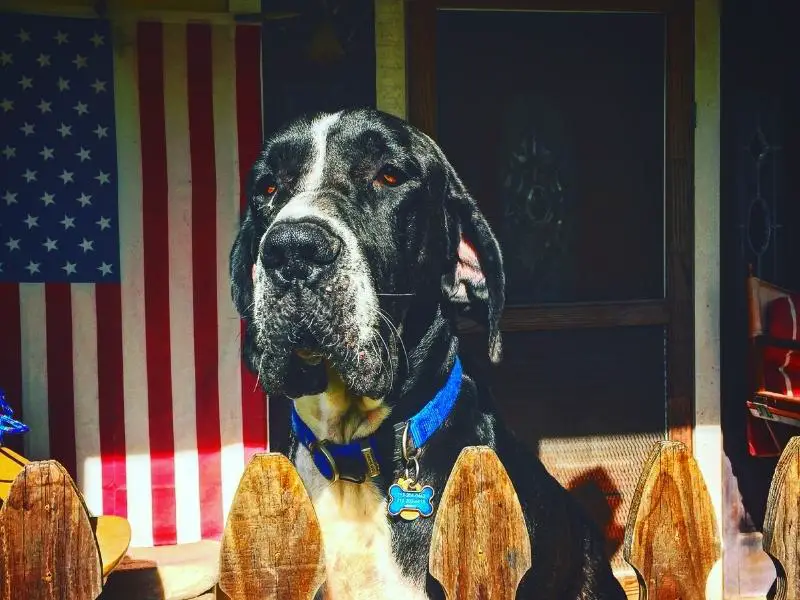
Breed Origin and History of the Great Dane Mastiff Mix
The Daniff, a blend of Great Dane and English Mastiff, is a notable creation in the canine world, emerging in the late 20th century. In my opinion, this breed stands out for its unique combination of traits distinct from its parent breeds.
Breeders aimed for a dog that balanced size and gentleness, resulting in the Daniff’s distinctive personality and physique. This hybrid shows a remarkable mix of its ancestors’ strengths while displaying a more moderate temperament, making it an ideal companion for those who admire large breeds but desire a calmer demeanor.
Each Daniff I’ve met has its own blend of characteristics, sometimes echoing the Great Dane’s temperament or the Mastiff’s robustness. This variability makes them especially fascinating and highlights the ongoing evolution of this unique breed. The Daniff’s development represents the exciting potential of thoughtful breeding, offering a blend of majesty and mildness. Let us discuss the parent breeds first before we focus on the mix.
Great Dane
The Great Dane, often referred to as the “Apollo of Dogs,” holds a special place in the canine kingdom. Originating in Germany, these dogs were initially bred for hunting wild boar, which demanded both strength and agility. Over time, their role shifted from hunters to noble companions, valued for their dignified presence.
In my time with Great Danes, I’ve consistently been impressed by their size and elegance. They stand tall, with a height ranging from 28 to 34 inches, and their well-muscled bodies can weigh anywhere between 110 and 175 pounds. Despite their imposing size, Great Danes are known for their gentle and loving nature. They exhibit a remarkable blend of strength and sweetness, often referred to as “gentle giants.”
One of the most striking characteristics of the Great Dane is its temperament. These dogs are friendly, patient, and dependable. They form strong bonds with their families and are known to be particularly gentle with children. Their approachability and gentleness are in stark contrast to their formidable size, making them a favored breed among dog lovers.
Great Danes are also known for their intelligence and trainability. At the kennel, I discovered that they respond well to positive reinforcement and consistent training, making them suitable for both experienced and novice dog owners. However, their size requires adequate space and exercise. They need regular walks and playtime to maintain their physical and mental health.
Health-wise, Great Danes are generally healthy, but they are prone to certain conditions like hip dysplasia, heart issues, and bloat. Their lifespan typically ranges from 8 to 10 years, and they require regular veterinary check-ups to maintain their health.
English Mastiff
The English Mastiff, known for its impressive size and kind demeanor, is a breed with a rich history. Originating from England, these dogs were used in ancient times for guarding and as war dogs, owing to their formidable size and protective instincts.
In my experience with English Mastiffs, their most striking feature is their sheer size. They are one of the heaviest dog breeds, with males often weighing between 160 and 230 pounds, and females slightly lighter. Despite their massive build, English Mastiffs possess a calm and affectionate nature. They are known for being gentle giants, much like the Great Dane, but with a more robust and muscular build.
English Mastiffs have a distinct temperament characterized by loyalty and a protective instinct. I love that they’re deeply devoted to their families and tend to be good with children. Their protective nature makes them excellent watchdogs, but they are not typically aggressive without cause. Instead, they exhibit a dignified and reserved demeanor, often being cautious around strangers.
Training and socialization are crucial for English Mastiffs. They respond well to gentle, consistent training methods. Due to their size, early training to ensure good manners is essential. I’ve also found that these dogs require regular exercise, but not as much as more energetic breeds. A few short walks and some playtime are usually sufficient to keep them happy and healthy.
English Mastiffs are prone to certain conditions like hip and elbow dysplasia, obesity, and cardiac issues. Their lifespan is generally around 6 to 10 years, which is enough time for you to bond with them. Additionally, ensuring a balanced diet for your English Mastiff is vital in maintaining their health and preventing obesity-related issues.
Great Dane Mastiff Mix Appearance
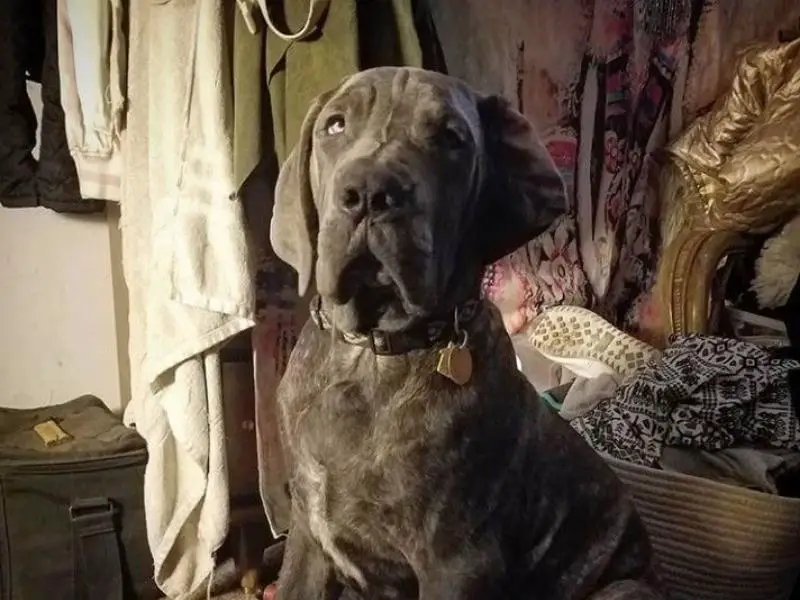
The Daniff is a large dog with long legs and a muscular build. The dog inherits the physical characteristics of both its parents, with a big head, a long tail, and a short, sleek coat. Most Daniffs look like a rounder, thicker version of the Great Danes.
Height and Weight
Great Dane Mastiff mixes are considered large dogs, with a height at the withers of 27–33 inches and a weight of 115–190 pounds. Like both its parent dogs, the daniff has a powerful, muscular build. I’ve also discovered that the size and weight of the dog depend on which of its parents it more closely resembles — English mastiffs are shorter but heavier than Great Danes.
Colors
Great Dane Mastiff mixes are typically black, brindle, fawn, harlequin, mantle, and blue. The dogs’ colors are similar to the Great Dane’s colors. Some daniffs are solid-color, while others are mottled, combining shades of fawn and brown.
Coat
The Great Dane Mastiff Mix boasts a single coat that is short, smooth, and dense. However, it’s worth noting that this breed is prone to shedding, which may not make it an ideal choice for individuals with allergies.
Head and Face Shape
The Daniff’s facial features are a harmonious blend of traits from both the Great Dane and the English Mastiff. It showcases the Great Dane’s striking long muzzle and powerful jaw, while also inheriting the distinctive wrinkles and jowls that are characteristic of the English Mastiff. Additionally, this breed mix is known for its endearing drop ears, gracefully hanging by the sides of the dog’s head, mirroring the attributes of both parent breeds.
Great Dane Mastiff Mix Personality and Temperament
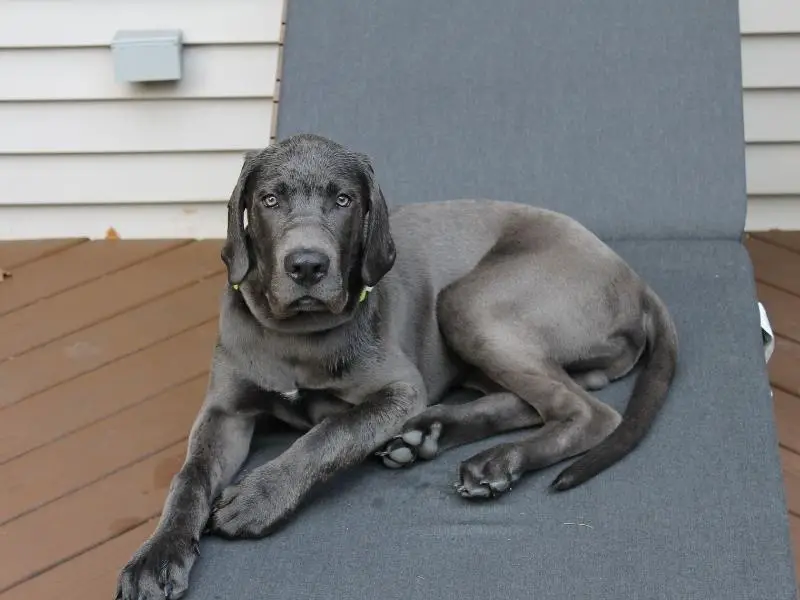
It’s interesting that the Great Dane Mastiff Mix inherits the positive and negative personality traits of its parents. For example, this breed mix is playful and energetic at puppy age, and calm, patient, and protective at adult age, making it an ideal family dog. Therefore, the Daniff should be socialized properly from an early age to prevent wariness and defensive behavior.
I did some research and according to the AKC temperament guide, the Great Dane is spirited, friendly, dependable, and courageous, and the English mastiff is good-natured, docile, and courageous. Both dogs are similar in nature, so these traits are likely to be passed on to the Daniff.
Barking
Great Dane mastiff mixes aren’t prone to barking excessively. These dogs are naturally watchful, and bark to alert their owners of potential danger. On top of that, Daniffs are intelligent, so they can easily be trained to reduce their barking tendencies if necessary.
Daniff Care Guide
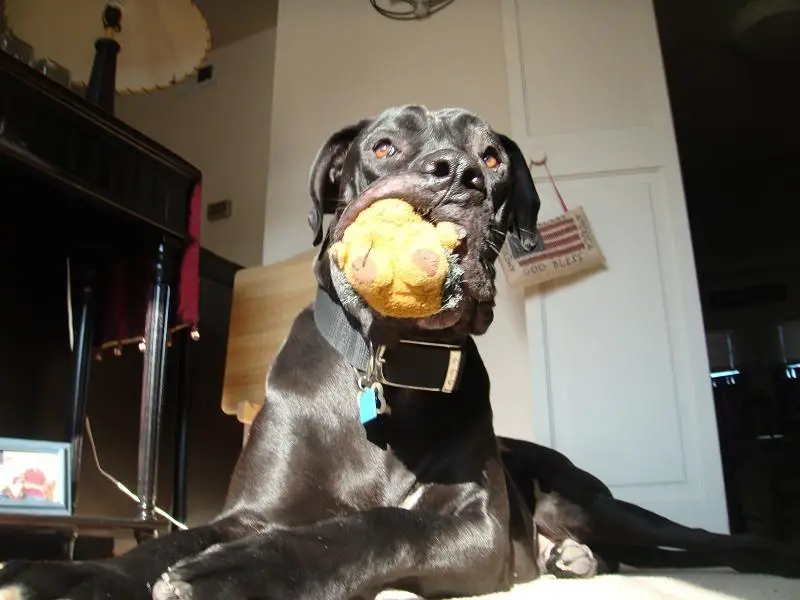
Caring for a Daniff, in my experience, comes with a moderate level of difficulty. While these dogs are generally gentle in nature, their substantial size and weight require ample attention to ensure their well-being. They have hearty appetites, demanding plenty of food, and their spaciousness needs call for adequate living space. Additionally, regular exercise is essential to keep them healthy and happy. Let us look at some care tips.
Grooming
Dental Health
Maintaining good dental hygiene is crucial for Daniffs. I’ve found that brushing their teeth at least twice a week helps prevent dental issues and keeps their breath fresh. Dental chews and toys designed to promote oral health can also be beneficial additions to their routine.
Ear Care
Due to their drop ears, Daniffs are prone to ear issues. It’s essential to check their ears regularly for signs of infection, wax buildup, or redness. If any problems are detected, consult a veterinarian for appropriate treatment and cleaning recommendations.
Nail Maintenance
Keeping their nails at an appropriate length is essential for your Daniff’s comfort and well-being. I recommend trimming their nails every 10 days or when you notice that their nails start clicking on the floor. Be cautious not to cut too close to the quick to avoid causing pain or bleeding.
Bathing
While Daniffs don’t require frequent baths due to their short coat, occasionally, a bath may be necessary to keep them clean and odor-free. When bathing, use a gentle dog shampoo to avoid skin irritation.
Wrinkle Cleaning
If your Daniff inherits the wrinkled skin of the English Mastiff, make sure to clean and dry between the folds regularly. Moisture and debris can accumulate in the wrinkles, potentially leading to skin irritation or infections.
Coat Care
Daniffs are known for their short fur, which makes grooming relatively simple. You’ll find that brushing their fur once or twice a week is usually sufficient to keep it in good condition.
Training and Exercise
In my experience, training and exercise are crucial aspects of caring for a Daniff.
Training
I can confidently say that it’s an enjoyable and rewarding experience. This breed mix is not only intelligent but also eager to please, making the training process relatively easy. However, it’s essential to keep in mind their intelligence and potential boredom, which emphasizes the importance of early training and socialization.
As such, I’ve found that starting training from a young age, ideally around eight weeks old, sets the foundation for a well-behaved and well-adjusted Daniff. Begin with basic commands like “sit” and “stay,” and focus on essential aspects such as toilet training and leash training.
One of the most effective methods you can employ is positive reinforcement. It helps them understand that good behavior is rewarded, which encourages them to repeat these actions.
Maintain a consistent training schedule and be patient with your pup as they learn. Avoid harsh punishments, as this breed mix responds much better to positive reinforcement and gentle guidance.
Socialization
Socialization is a critical component of Daniff training. Exposing your puppy to various people, animals, environments, and situations during their early months helps them become friendly, obedient, and well-rounded adults. Encourage positive interactions with other dogs and people to build their confidence and reduce any potential shyness or aggression.
Exercise
Daniffs are energetic dogs with a lot of vitality to expend. To keep them physically fit and mentally stimulated, it’s recommended to provide them with 30–60 minutes of daily exercise. This should include daily walks and playtime with a variety of toys. Given their large size and high energy levels, it’s important to note that the Daniff mix may not be suitable for apartment living or for owners with a sedentary lifestyle.
Mental Stimulation
Great Dane Mastiff mixes are intelligent dogs that require mental stimulation on a daily basis. Offering them a variety of toys is a great way to engage their minds and prevent boredom or destructive behavior. Consider providing them with large fetch balls, chew toys, tug toys, frisbees, and other interactive toys to keep their brains active and occupied throughout the day. This mental exercise is just as important as physical exercise for their overall well-being.
Feeding Guide for Your Great Dane Mastiff Mix
Feeding a Daniff requires careful consideration of various factors to ensure their health and well-being. Here are some essential guidelines for feeding this breed:
Feeding Schedule and Frequency
Establishing a consistent feeding schedule is crucial for your Daniff. I recommend feeding them at the same times each day to create a routine. Generally, two to three meals per day are suitable for Daniffs. Splitting their daily food intake into multiple meals helps prevent digestive issues and minimizes the risk of bloat, a condition they are prone to due to their size.
Portion Control
Portion control is essential to manage your Daniff’s weight and prevent overeating. The recommended daily food intake for a Daniff is about 6 to 10 cups of high-quality kibble, equivalent to approximately 2,500 to 3,000 calories. However, the specific amount may vary depending on factors such as age, activity level, and individual metabolism. Consult your veterinarian to determine the ideal portion size for your dog.
Hydration
Maintaining proper hydration is crucial for Daniffs. Ensure that they have access to fresh, clean water at all times. Especially during warm weather or after physical activity, monitor their water intake to prevent dehydration.
Special Dietary Considerations
Daniffs may have specific dietary requirements or sensitivities, so it’s important to choose a dog food that suits their needs. Consider specially-formulated dog food for large breeds with medium energy requirements. Some Daniffs may benefit from diets that address joint health or other specific concerns.
Treats and Snacks
While it’s tempting to indulge your Daniff with treats and snacks, I advise you to do so in moderation. Excessive treats can lead to weight gain and disrupt their balanced diet. Opt for healthy and appropriately-sized treats, and consider using them as rewards during training sessions.
Common Health Concerns for the Great Dane Mastiff Mix
Daniffs are prone to a number of large dog health concerns that affect the parent breeds. Some of these concerns can be avoided by buying a puppy from a reputable breeder who has screened the parent dogs for common health issues, and some can be avoided by raising the dog responsibly.
Bloat
It’s a problem that affects many breeds. Bloat, or gastric dilatation-volvulus, occurs when a dog’s stomach fills with food, fluid, or gas, causing the stomach to twist. Symptoms you may notice include a swollen or distended abdomen, restlessness, pacing, distressed behavior, rapid breathing, and retching without vomiting. Bloat is a serious condition that requires immediate medical attention, so get your pet to the vet fast. You can reduce the risk of bloat by preventing your dog from overeating, eating too quickly, drinking too much water at once, or exercising after eating.
Hip Dysplasia
Hip dysplasia occurs when one or both hip joints develop abnormally, causing pain, swelling, and arthritis.
When a Daniff is suffering from hip dysplasia, you may notice signs such as limping, stiffness, a peculiar way of running with both back legs moving together, and difficulty in activities like jumping or using stairs.
In the unfortunate event that hip dysplasia is diagnosed, it can be managed with a combination of treatments. These typically include exercise therapy, weight control (if needed), and the administration of anti-inflammatory pain relief medications. It’s essential to work closely with a veterinarian to develop a treatment plan tailored to your Daniff’s specific needs.
Joint Health
Daniffs, like many large breeds, are susceptible to joint issues. From my experience, it’s essential to monitor their joint health, especially as they age. Conditions such as osteoarthritis can affect their mobility and comfort. Consulting with a veterinarian for joint supplements or therapies can help maintain their joint health.
Heart Health
Large dogs like Daniffs can be prone to heart-related conditions. It’s advisable to have regular check-ups with a veterinarian to assess their cardiac health. Monitoring for symptoms like coughing, lethargy, or difficulty breathing can help detect heart issues early.
Obesity
Daniffs can gain weight easily due to their large size and appetite. Maintaining a healthy weight is crucial to their overall well-being. Ensure they receive an appropriate portion of high-quality food, and avoid overfeeding or excessive treats.
Skin and Coat
Some Daniffs may be prone to skin issues or allergies. Regular grooming and inspecting their skin for any signs of irritation or infection can help address such concerns promptly. Choosing a diet that supports skin health can also be beneficial.
Eye Health
While not a common issue, Daniffs can experience eye problems. Regular eye check-ups and monitoring for symptoms like redness, discharge, or squinting can help detect and address potential eye conditions.
Great Dane Mastiff Mix Price
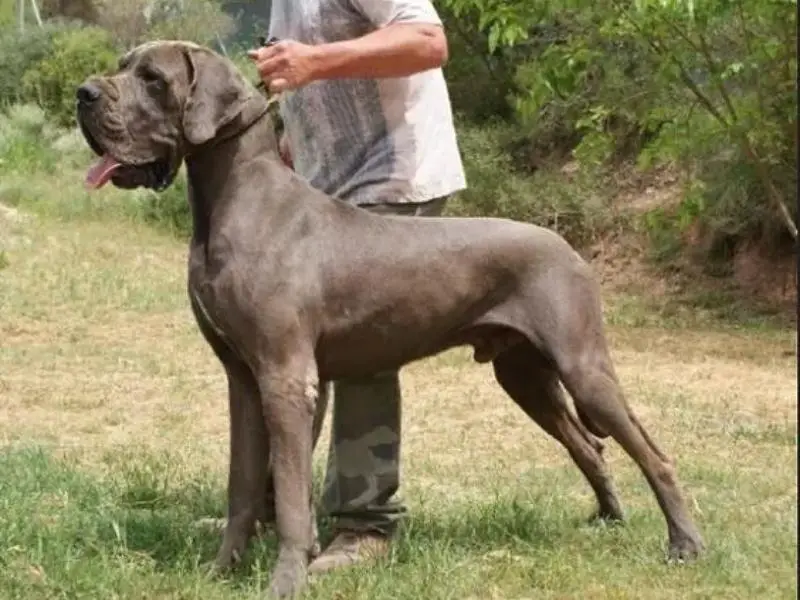
The Great Dane Mastiff Mix is a moderately-priced dog. The cost of a daniff depends on whether you buy a puppy from a breeder or adopt a dog from a shelter.
How Much is a Daniff?
A Great Dane Mastiff Mix typically costs $500 to $900. The price of the dog varies depending on factors including:
- Whether you buy a dog or a puppy: Puppies are around $400 more expensive than dogs
- Whether you adopt or buy a dog: Adoption fees are usually $50–$200, much cheaper than the cost of buying a dog from a breeder
- The breeder’s reputation: Reputable breeders often have higher prices than other breeders
How Much Does it Cost to Own a Great Dane Mastiff Mix?
The monthly cost of owning a Great Dane Mastiff Mix is about $120. Food is the biggest cost of owning this breed mix. Other costs to account for are new toys, grooming and walking supplies, healthcare, and optional costs, like professional dog sitting, training, or dog walking.
Is a Daniff Right for You?
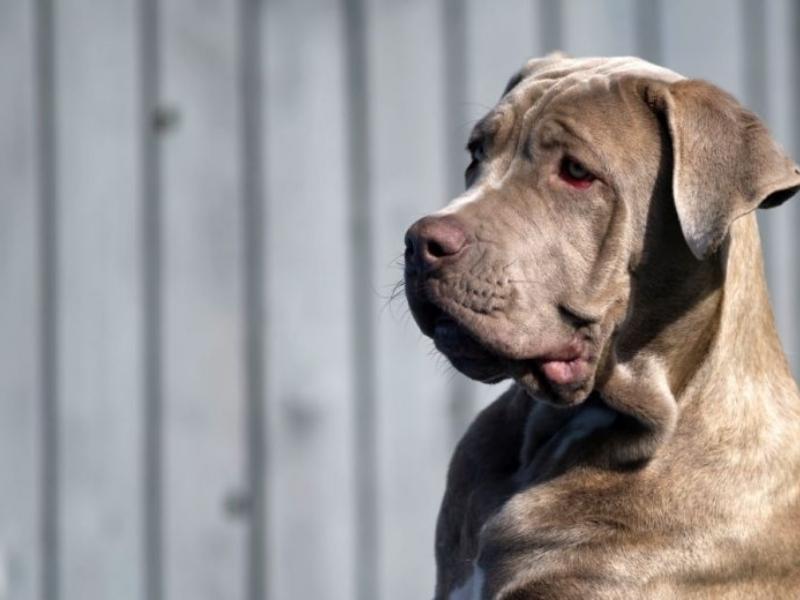
The Daniff is a friendly, laid-back dog, but it isn’t suitable for some people or lifestyles.
Great Dane Mastiff Mixes are Suitable for:
Great Dane Mastiff mixes are loving, nurturing dogs with a protective instinct, so they’re great pets for families with children. The dogs are large and take up a lot of space, so they’re best suited to roomy homes with secure backyards. Daniffs are suitable for experienced dog owners who have the time and patience to train and raise a large dog breed.
Great Dane Mastiff Mixes are NOT Suitable for:
Great Dane Mastiff mixes are big dogs that need to be properly trained and socialized to prevent defensive and aggressive behavior, so they’re not suitable for people who aren’t prepared for the responsibility of training a dog. Due to their large size and moderate exercise needs, daniffs aren’t good pets for inactive people or people living in small homes or apartments. Great Dane Mastiff mixes have big appetites, so they’re not ideal for people who can’t afford to spend a lot of money on quality dog food.
FAQs on Great Dane Mastiff Mix
What is the average lifespan of the Great Dane Mastiff mix?
The average lifespan of the Great Dane Mastiff mix is typically in the range of 8 to 12 years. However, it’s important to note that several factors can influence a dog’s lifespan. These include their diet, activity level, overall health, and the environment in which they live.
How big do Great Dane Mastiff mixes get?
Great Dane Mastiff mixes are large dogs, and their size can vary. On average, they can grow up to 33 inches tall at the shoulder and weigh as much as 190 pounds. Keep in mind that individual dogs may fall within this range or be slightly larger or smaller.
Are Great Dane Mastiff mixes good family dogs?
Yes, Great Dane Mastiff mixes can make excellent family dogs. They are known for their loving and protective nature. However, early socialization and training are essential to ensure they grow up to be well-behaved and friendly around family members and other pets.
Do Great Dane Mastiff mixes require a lot of exercise?
Yes, Great Dane Mastiff mixes have high energy levels and need regular exercise to stay healthy and happy. Providing them with 30 to 60 minutes of daily exercise, including walks and playtime, is essential. Due to their size and energy levels, they are not well-suited for apartment living or inactive owners.
Are Great Dane Mastiff mixes prone to specific health issues?
While Great Dane Mastiff mixes can be prone to certain health issues like hip dysplasia and bloat, they may also face other concerns common to large breeds, such as joint problems and heart-related conditions. Regular veterinary check-ups and a healthy lifestyle can help mitigate these risks.
What is the temperament of a Great Dane Mastiff mix?
Great Dane Mastiff mixes are known for their loving and protective temperament. They are often gentle giants and can be excellent companions. However, early training and socialization are crucial to ensure they exhibit friendly and obedient behavior.
The Rewarding Experience with a Great Dane Mastiff Mix
From their impressive size to their loving temperament, Daniffs are a unique blend of two wonderful breeds. However, owning one comes with responsibilities, including proper grooming, training, and health considerations. But the joy and loyalty they bring to your life are worth every effort.
Remember, early training and socialization are key to raising a well-rounded Daniff. Keep their exercise needs in mind, provide mental stimulation, and monitor their health regularly. And, of course, cherish the moments of cuddles and playtime with these gentle giants.


Be the first to comment